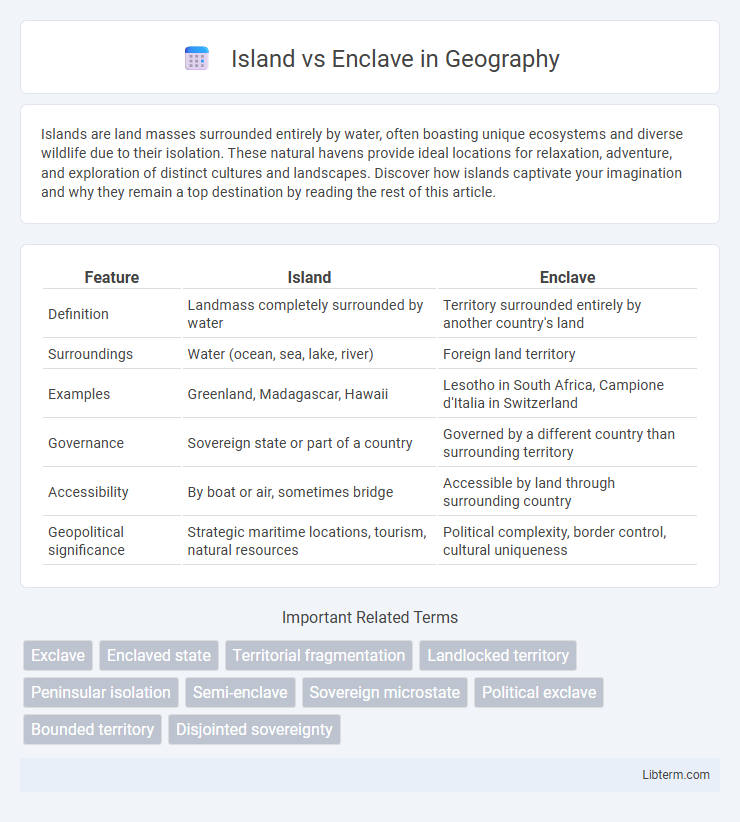Islands are land masses surrounded entirely by water, often boasting unique ecosystems and diverse wildlife due to their isolation. These natural havens provide ideal locations for relaxation, adventure, and exploration of distinct cultures and landscapes. Discover how islands captivate your imagination and why they remain a top destination by reading the rest of this article.
Table of Comparison
| Feature | Island | Enclave |
|---|---|---|
| Definition | Landmass completely surrounded by water | Territory surrounded entirely by another country's land |
| Surroundings | Water (ocean, sea, lake, river) | Foreign land territory |
| Examples | Greenland, Madagascar, Hawaii | Lesotho in South Africa, Campione d'Italia in Switzerland |
| Governance | Sovereign state or part of a country | Governed by a different country than surrounding territory |
| Accessibility | By boat or air, sometimes bridge | Accessible by land through surrounding country |
| Geopolitical significance | Strategic maritime locations, tourism, natural resources | Political complexity, border control, cultural uniqueness |
Definition of Island and Enclave
An island is a landmass completely surrounded by water, separated from other land areas by natural water bodies such as oceans, seas, rivers, or lakes. An enclave is a territory or part of a territory entirely enclosed within the boundaries of another political entity, often a country or region, without any water boundary separation. While islands are defined by geographic isolation, enclaves are defined by political and administrative boundaries.
Key Differences Between Islands and Enclaves
Islands are land masses completely surrounded by water, typically found in oceans, seas, rivers, or lakes, while enclaves are territories entirely surrounded by another country or region's land. The key difference lies in their geographic context: islands are isolated by water, whereas enclaves are isolated by political or administrative boundaries on land. Islands often have unique ecosystems and maritime boundaries, whereas enclaves involve complex jurisdictional and sovereignty issues between surrounding states.
Geographical Formation of Islands
Islands are naturally formed landmasses surrounded entirely by water, often created through volcanic activity, coral accumulation, or sediment deposition. In contrast, enclaves are territories entirely surrounded by another political entity and are not defined by natural geographical formation but by political boundaries. The distinct formation processes of islands emphasize their isolation by water, whereas enclaves highlight administrative and jurisdictional encirclement.
How Enclaves Are Created
Enclaves are created when a portion of land belonging to one political or administrative entity becomes entirely surrounded by another entity, often due to historical treaties, land swaps, or border negotiations. They can result from complex geopolitical agreements that leave pockets of territory isolated within foreign borders, frequently causing challenges in governance and access. Unlike islands, which are natural landmasses surrounded by water, enclaves are defined solely by political boundaries within continuous land areas.
Famous Islands Around the World
Famous islands around the world, such as Hawaii, Madagascar, and the Maldives, are distinct landmasses surrounded entirely by water, offering unique ecosystems and cultural heritage. Islands differ from enclaves, which are territories completely surrounded by the land of another state, lacking the natural water boundaries that characterize islands. Iconic islands attract millions of tourists annually due to their geographic isolation and natural beauty, contributing significantly to local economies.
Notable International Enclaves
Notable international enclaves such as the India-Bangladesh enclaves, until their exchange in 2015, highlighted complex sovereignty and administrative challenges faced when territories are entirely surrounded by another country, contrasting with islands that are naturally separated by water. The former Soviet Union contained multiple enclaves within its borders, exemplifying historical territorial disputes with geopolitical implications. These enclaves often affect trade, security, and the daily lives of residents due to restricted access and governance by foreign administrations.
Political and Cultural Significance
An island functions as a geographically isolated landmass surrounded by water, often fostering unique political structures and distinct cultural identities due to limited external influence. An enclave is a territory entirely surrounded by another state's land, leading to complex political relationships and cultural integration challenges within the host nation. The political significance of islands includes strategic military control and sovereignty claims, while enclaves often highlight issues of governance, minority rights, and diplomatic negotiation between states.
Economic Impacts of Islands and Enclaves
Islands often face higher costs for transportation and trade due to their geographic isolation, impacting economic development and increasing reliance on imports. Enclaves may experience limited access to markets and infrastructure, restricting economic integration and growth opportunities. Both islands and enclaves encounter unique challenges in attracting investment and sustaining industries, influencing regional economic policies and development strategies.
Challenges of Governance and Access
Islands face governance challenges due to physical isolation, leading to limited infrastructure and dependency on maritime or air transport, complicating access to essential services and emergency response. Enclaves struggle with political and administrative coordination since they are territorially surrounded by another state, causing difficulties in law enforcement, resource allocation, and cross-border movement. Both require tailored governance strategies to address restricted accessibility and jurisdictional complexities to ensure effective public administration and service delivery.
Comparisons: Island vs Enclave in Modern Geography
Islands are land masses completely surrounded by water, forming distinct geographic units often isolated from mainland territories, while enclaves are territories entirely surrounded by another state's land, creating unique political and administrative challenges. Islands can vary dramatically in size, climate, and population, influencing their economic and cultural development, whereas enclaves are typically smaller and defined by political boundaries rather than natural features. The distinction between islands and enclaves in modern geography highlights the interplay between physical geography and human-imposed borders, affecting issues like sovereignty, access, and governance.
Island Infographic

 libterm.com
libterm.com